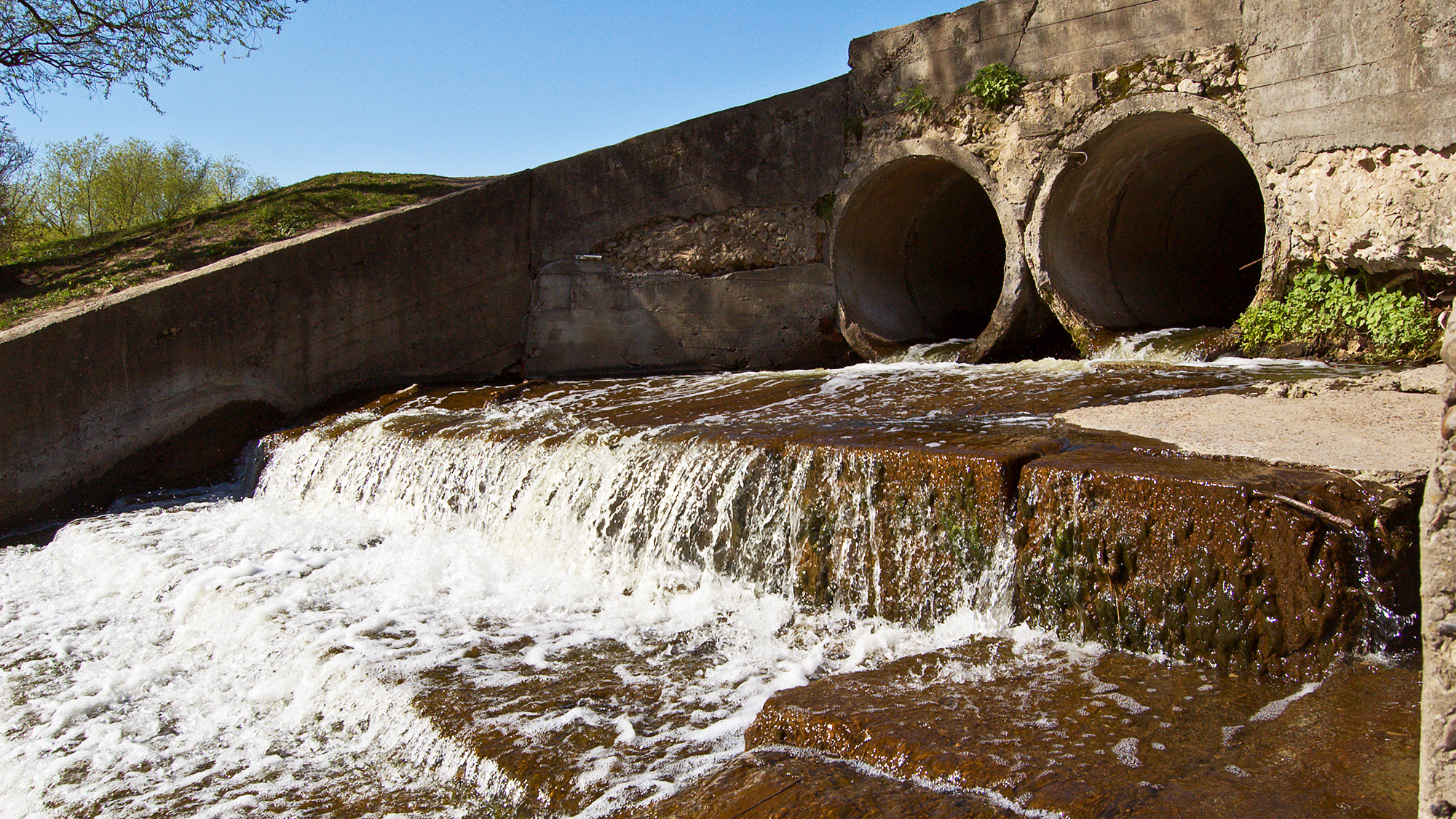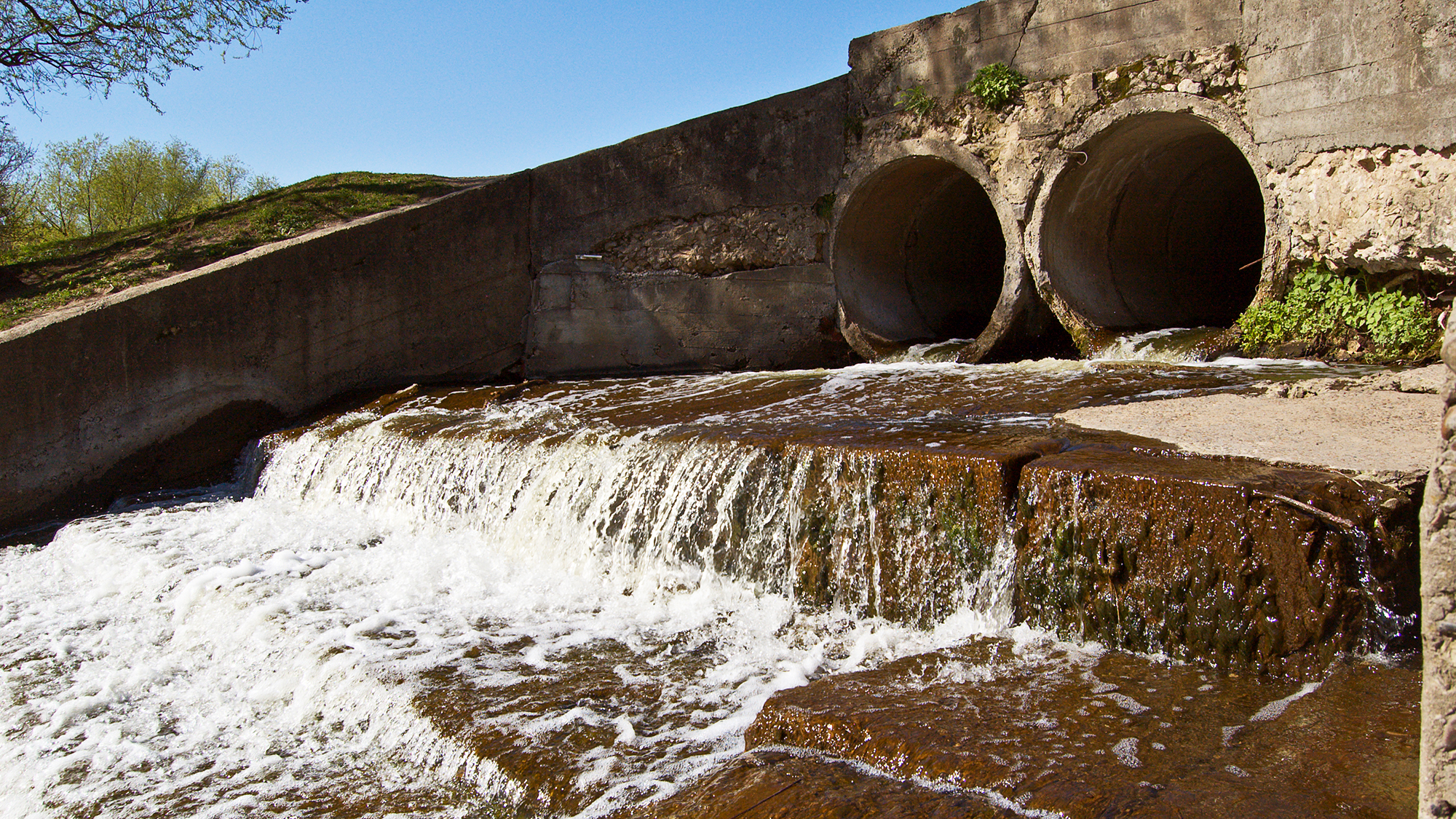
Every time it rains and every time you flush a toilet, all that water has to go somewhere. The path it takes has downstream consequences for public health. A growing body of research indicates that aging pipes and wastewater systems, combined with heavy rain events made more common with climate change, can boost your risk of becoming ill.
Many municipalities along the East Coast and in the Midwest rely on a type of old, outdated wastewater management infrastructure called combined sewer systems, where sewage mixes with run-off (water that flows into storm drains from the street) before heading to wastewater treatment. Ideally all of this contaminated water would get cleaned up before it’s re-released into the environment. But during heavy rains, the volume of run-off entering these systems frequently overwhelms transport and treatment capacity. Instead of cycling through a wastewater treatment plant, that sewage-filled, untreated overflow gets dumped directly into waterways like the Hudson River in New York City .
These combined sewer overflow (CSO) events pose well-established environmental risks, and also a less-commonly discussed public health risk. The number of emergency room visits for acute gastrointestinal illness (think severe vomiting and diarrhea) spiked by upwards of 60 percent following the largest sewer overflow events in communities along the Merrimack River in northern Massachusetts between 2014 and 2019, according to a recently published study in the journal Environmental Health Perspectives. The findings are closely in line with similar studies of the same region, which found associations between extreme rainfall and ER visits and a different type of sewer overflow event and illness. And it’s not just an issue in northern Massachusetts.
In Atlanta, Georgia, researchers observed that large CSO events were associated with a nearly 10 percent increase in ER visits for GI illness in the week following the overflow, in a 2022 publication cataloging more than a decade of data. A 2017 study determined that children living within 500 meters of combined sewer overflow outlet sites in Cincinnati, Ohio were about 16 percent more likely to end up in the emergency department for symptoms like severe vomiting and diarrhea in the aftermath of heavy rainfall and CSO events.
In the U.S. and other wealthy countries, “people often think that we don’t have major issues with waterborne disease, and it’s a misconception,” says Heather Murphy, an associate professor of pathobiology and environmental health researcher at the University of Guelph in Ontario. “People assume that water is always safe in North America, but it’s not necessarily.”
How water can make us sick
How people contract waterborne illness following CSO events or other heavy rainfall and flooding isn’t clear from all of these studies. “We don’t know the exact mechanism of how people might be getting ill,” says Jyotsna Jagai, an author on all three of the Massachusetts studies and an adjunct assistant professor of environmental health at the University of Illinois in Chicago.
But the researchers have hypotheses. The most well-supported is that people are becoming sick after direct contact with contaminated surface water through recreational activities like swimming, wading, boating, or fishing, says Jagai. Even something as simple as taking your dog to the lake or river and forgetting to wash your hands thoroughly before eating, or a child splashing around in a puddle could be a transmission route. In the Massachusetts study, documented hospital visits for GI disease were highest in the summer, when outdoor activity is also likely highest. In the Atlanta research, higher income areas experienced a larger spike in GI illness after CSO events, indicating a possible link between recreation access and disease.
In contrast, the least well-supported theory is that sewage can become aerosolized and breathed in, increasing the hyper-local risk of contracting illness, says Beth Haley, lead author on the most recent Massachusetts study, which she worked on as a public health doctoral student at Boston University, and current post-doctoral researcher. “That’s much more hypothetical than proven out in the evidence,” she adds.
In between is the question of drinking water. Municipal drinking water is, in most cases, a less likely–though still possible–candidate for disease exposure than recreation. Even when public drinking water is sourced from waterways where CSO events occur, treatment plants generally do a very thorough job of testing, monitoring, and ameliorating contamination, notes Jagai. When things go wrong, there are alert systems in place to ensure the public is aware and can act accordingly, like boil water advisories. “To me, a boil water advisory is proof the system is working exactly as it should be. Like, ‘I got notified to not drink my water because the city was monitoring conditions and telling me there was a problem,’” says Karen Levy, senior author of the Atlanta study and a professor of environmental health at the University of Washington.
Yet on occasion, things might fall through the cracks–literally. Though water may leave a treatment plant safe for consumption, along the way, aging pipes may be damaged and saturated soil–particularly soil saturated with overflowed, untreated sewage–could allow some pathogens to seep in, notes Levy. “A very small pressure drop in the system can be a source of an intrusion event,” she adds. And, in exceptional cases, very large rainfall and CSO events can make the water incoming to treatment plants so turbid that it’s hard to effectively treat because microbes can collect on sediment particles, say Jagai and Levy. Viruses and protozoan pathogens may be particularly difficult for standard water treatment strategies to manage, says Haley.
Even if a plant is successfully treating water to meet EPA safety thresholds, a large CSO event still can mean more contamination than normal. Water coming out of your tap inevitably contains some microbes, “it’s definitely not sterile,” says Levy. For most people at most times, that microbe load is perfectly safe. Yet people who are immunocompromised, elderly, or very young may not “necessarily be able to manage that higher contamination level and might be at higher risk of GI illness,” says Jagai. The most recent Massachusetts study did not find a significant population-level divide in GI illness case numbers depending on drinking-water source, but the data also doesn’t entirely rule it out as a factor, Jagai notes.
A handful of other assessments have concluded that, in some instances, drinking water can be a cause of illness. Nearly two decades ago, researchers reported that children living in zip codes reliant on Lake Michigan as their drinking water source had a higher rate of hospital visits for diarrheal illness following a sewage overflow into the lake, compared with children in zip codes with other municipal water sources. In Canada, which also has some combined sewer systems, Murphy has conducted research estimating that hundreds of thousands of cases of acute GI disease result from contaminated drinking water each year. A similar assessment of the U.S. published by the Centers for Disease Control and Prevention in 2023 estimated that more than 1.1 million cases of waterborne illness in a year were linked to drinking water (more than 5.6 million were associated with recreational water sources, per the same study).
How to keep yourself healthy
That doesn’t mean you should stop drinking your tap water or go out and buy bottled, emphasizes Levy. “While CSOs are an issue, particularly after heavy rainfall events, and that’s something we should be paying attention to as a society–as individuals we should feel incredibly lucky that we can open up our taps and most of the time we can drink that water safely,” she says. “I think people can trust that water utilities are measuring and monitoring the [microbial] conditions in the water.” Always pay attention to water alerts and guidance in your area, and if you are at increased risk of infection, consider a little bit of extra caution (ex: boiling water) in the aftermath of exceptional rain events or floods.
If you are reliant on private well water, know that you may be at higher risk of waterborne disease, and consider timing your water testing to check for microbial contamination following heavy rainstorms (which can overflow septic systems), to pick up on vulnerabilities that might otherwise be missed, suggests Murphy.
Most importantly, take the risk of recreating on potentially contaminated water seriously and wash your hands if you do come into contact with it. Generally, public health agencies encourage people to stay out of and away from waterways for 48 hours after a CSO event, Haley says. “I think that’s a pretty good rule of thumb,” she adds–noting that the time lag between CSO events and ER visits in her study generally matches up with the idea that contamination levels are highest for about two days after intense storms.
A bigger fix
Ultimately, the problem of CSOs and water contamination can’t be remedied at the individual level, and it’s set to become more pressing. CSO systems are no longer built, but cities that inherited them from decades or centuries past still live with the consequences, which become more severe as populations grow and climate change shifts precipitation patterns. Across large swathes of the U.S., including the East and Midwest, extreme precipitation events are becoming more common and intense–adding stress to the already inadequate infrastructure. In the Northeast, observed precipitation from extreme rains has already risen by more than 50 percent, compared to 1958 levels. “These are the exact conditions that are risky for a combined sewer system,” says Haley. Unfortunately, addressing the issue is complicated and extraordinarily expensive, she adds.
“A lot of municipalities that manage these legacy combined sewer systems do not have the financial capacity to fix them in the way that they would need to, to have zero CSO events… We’re talking about hundreds of millions of dollars, sometimes billions, to completely separate sewer systems,” says Haley. Another option is adding wastewater treatment capacity, which some cities like Portland, Oregon, and Boston have done–but even that is still very costly and inaccessible to smaller cities without federal support, she adds. We need more capital investment and federal policy supporting infrastructure development, she says. “That’s not a hot take. We have many well-documented issues with our infrastructure that need additional investment.”
The EPA already requires cities with combined sewer systems to have mitigation plans in place to reduce the impact of raw sewage flowing into waterways. Yet these haven’t proved to be enough. Haley points out that many of these plans do not account for changing rainfall patterns or projected precipitation increases due to climate change. And even existing plans haven’t necessarily been implemented or tracked as promised. A 2023 report from the U.S. Government Accountability Office noted that the EPA has failed to set goals for or track mitigation efforts.
Everyone has the right to access safe and healthy natural spaces. Spending time in nature, be it a forest or alongside a river, has proven public health benefits, notes Haley. In an ideal world, people would be able to reap those rewards without fear or illness. “It would be a disservice for people to stop using public natural areas,” she says. “At the same time, we have to be aware of and understand the risks.”

